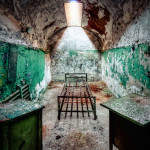We run our website the way we wished the whole internet worked: we provide high quality original content with no ads. We are funded solely by your direct support. Please consider supporting this project.
Twenty Arguments Against Cameron’s “The Lost Tomb of Jesus”
On March 4th, 2007, the Discovery Channel aired James Cameron’s much celebrated documentary, “The Lost Tomb of Jesus.” The documentary basically gives a new spin on an old discovery.
In 1980, a first century tomb was discovered in Talpoit (a southern suburb of Jerusalem) that contained 10 ossuaries (that is, boxes that contain the remains of people). Six of the ossuaries have names etched on them: “Jesus, son of Joseph,” “Maria,” “Mariamne,” “Matthew,” “Judas, son of Jesus,” and “Jose” (a diminutive of Joseph). The documentary argues that it’s not coincidental that these names all correspond to figures in the New Testament. Beyond the obvious associations of Jesus, Joseph, and Judas “son of Jesus,” Cameron’s documentary argues that “Maria” is Jesus’ mother, Mariamne is Mary Magdalene (who was supposedly included in the tomb because she was Jesus’ wife), and Matthew and Jose are supposedly Jesus’ brothers (or, alternatively, Matthew could have been buried in the family tomb because he was simply so close to the family).
I found this documentary to be remarkably weak and it should not concern any informed Christian. Here are my top twenty reasons why.
1) The “Jesus tomb” ossuaries were discovered over 25 years ago, yet throughout this time hardly any scholars – including the leading experts in archeology and the vast majority of non-Christian scholars – have concluded that the odds this tomb contained the remains of Jesus and others mentioned in the New Testament to be a hair’s breath above zero. That alone has got to tell you something.
2) The names on these ossuaries are all among the most common names for first century Jews. This is one of the main reasons the vast majority of scholars find the alleged correspondence between these six names and the names found in the New Testament to be nothing more than an insignificant coincidence.
3) It’s not even certain the name “Jesus” in this tomb is really “Jesus.” A few scholars think it may more likely refer to the name “Hanun.”
4) The documentary made much of the fact that Mariamne (“Mary”) is followed by “mara” on her ossuary. This was interpreted in Cameron’s documentary to mean “master” or “teacher,” which in turn was used to support linking this Mariamne with Mary Magdalene. Now, the only evidence that Mary Magdalene was regarded as a teacher comes from a fourth century Gnostic document. This is extremely poor evidence, to say the least. Even more importantly, most scholars argue that “mara” is simply an abbreviation for “Martha.” If this is the case, this ossuary may have contained the remains of two different women (possibly sisters) since we know that ossuaries often contained more than one person’s remains.
5) The association of Mariamne with Mary Magdalene is problematic for another reason: Mary was called “Maria” (not “Mariamne”) in the Gospels and throughout the early centuries of Church history. We don’t find Mary Magdalene identified as “Mariamne” until the fourth century (in that quasi-gnostic work). This is about as tenuous as historical evidence gets. It’s the same kind of evidence cited in The Da Vinci Code to suggest Mary was married to Jesus, which this documentary also espouses. If someone is going to build a case relying on this sort of lame “evidence,” they could just as easily (and ridiculously) argue that Mary was married to Philip, since one Gnostic text from this same time period (the Acts of Philip) suggests this. The bottom line is that appealing to non-historical works that are centuries removed from the people and events they talk about puts one on very thin ice.
6) The inscriptions on these ossuaries are in three different languages: Hebrew, Aramaic, and Greek. One has got to wonder why? This may suggest that, if this is in fact a family tomb (see below), it is a multi-generational tomb, and this significantly damages the thesis of Cameron’s documentary. It’s also significant that the Mary whom this documentary identifies as Mary Magdalene has her inscription in Greek, while Jesus, who is supposed to be her husband, has his inscription in Aramaic. This is not at all what we would expect if, in fact, these two were man and wife. In my humble non-expert opinion, the variety of inscriptions, combined with other factors (see below) indicates that this most likely was not a family tomb. And if it wasn’t a family tomb, the statistical argument this documentary relies so heavily on (which is weak in the first place) is shot to pieces.
7) Speaking of inscriptions, it’s significant that they were all done in a very sloppy, careless manner. Jews typically collected the remains of a buried person and put them in ossuaries a year or more after they died. If Jesus’ family and friends had a year to plan his entombment, wouldn’t they have taken a bit more care inscribing his name on his ossuary? In fact, since dignitaries were usually given ornate ossuaries (cf. the ossuary of Ciaphas the High Priest), wouldn’t we have thought Jesus’ ossuary would be a little more ornate than the others? As it stands, Jesus’ ossuary is perfectly ordinary.
8 ) Only wealthy families could afford family tombs, but Jesus’ family was poor.
9) As I mentioned earlier, two of the ossuaries identify the person whose remains it contains by associating them with their father (that is, Jesus son of Joseph and Judas son of Jesus). Now, this was a common practice among Jews from Judea. In the area around Galilee, however, people were identified by their hometown. Unfortunately for the documentary’s thesis, Jesus’ family was from the area around Galilee, not Judea. Hence we would expect an ossuary containing the remains of the biblical Jesus to read, “Jesus of Nazareth” (as the Gospels record it), not “Jesus son of Joseph.”
10) Family tombs were customarily built in the family’s hometown. So, if Jesus’ family could have somehow acquired enough money to purchase a family tomb (see #8) we would expect it to be in located in Nazareth, not a suburb of Jerusalem (Tolpoit).
11) The documentary struggles trying to fit Matthew into its thesis that the Tolpoit tomb is the lost tomb of Jesus, for there’s not one shred of evidence that Jesus had a brother by this name. The documentary tries to argue for this possibility, however, by noting that the genealogy of Mary in Luke (ch.3) is “consistent with” her having had a son named “Matthew,” since we find variations of “Matthew” in her family tree. This is true, but it would also be true for any number of genealogies of other first century Jewish women. Remember, “Matthew” (and variations of it) was a very common name. Not only this, but there’s no evidence I know of that supports making an appeal to the names of ancient relatives even relevant. Did Jewish families generally look into their very distant past when deciding names for their children?
12) Perhaps realizing that the case for Matthew being Jesus’ brother is pretty weak, the documentary entertains the possibility that Matthew was Jesus’ disciple mentioned in the New Testament (and the traditional author of the Gospel bearing his name). Now, one might immediately wonder why Matthew would have been included in Jesus’ family tomb instead of other disciples who (according to the Gospels) seemed to have had a closer relationship with Jesus (e.g. John). But even more importantly, this concession completely screws up the documentary’s thesis that this was Jesus’ family tomb. For once we grant that one of the ossuaries contains the remains of a non-family member, we undermine any grounds we might think we have for identifying any of the ossuaries as belonging to family members. In other words, if Matthew might not have been a family member, why should we feel compelled to conclude that Maria or Mariamne or Jose were family members? Maybe they too were just close friends of the family? And once we’ve come this far, it’s clear we no longer have any grounds for identifying this as a family tomb in the first place! In fact, since “Jesus” was an extremely common name among first century Jews, I don’t see why we should even feel compelled to accept that the Jesus who is the “son of Joseph” is the same Jesus who is identified as the father of Judas.
13) The only brother of Jesus the Gospels tell us anything about is James. We also learn about this brother of Jesus from two references to him in Josephus’ writings. Why isn’t his ossuary in the tomb? About three years ago a person claimed to have found a first century ossuary that had inscribed on it, “James, the son of Joseph, brother of Jesus.” Some scholars think it is authentic, others not. I suspect it is, but whether it is or isn’t doesn’t matter right now. What matters is that, whether authentic or not, it wasn’t in the Talpoit tomb. Nor could it have come from the Talpoit tomb, since it’s a different kind of ossuary and contains a different kind of inscription compared to the ossuaries in this tomb. So whatever we make of the James ossuary, the point stands that the absence of James in the Talpoit tomb is evidence that this was not the tomb of Jesus’ family.
14) The DNA sample from the Jesus ossuary didn’t match the DNA from Mariamne’s ossuary, suggesting further that this was not a family tomb. Amazingly, the Cameron documentary tries to use this fact to prove that Mariamne must have been the wife of Jesus! This is as arbitrary a leap of faith as I can imagine. Why Jesus’ wife? Why not Jose’s or Matthew’s or Joseph’s wife? Or, why not simply suppose she was a family friend, like the documentary admits Matthew may have been? Then again, why assume this was a family tomb in the first place?
15) In the Gospels, no one except hostile witnesses (see Jn 6:62) identified Jesus as “the son of Joseph.” In fact, he’s identified as “the son of Mary” (Mk 6:3), which is very unusual and possibly significant in its own right. First century Jews were usually identified by their father, not their mother, even after their father was dead. (It was an intensely patriarchal culture). The fact that the Gospels report Jesus being identified by his mother plausibly suggests that Jesus’ own town folk didn’t buy Mary’s story of the virgin birth. In any case, it’s extremely unlikely Jesus’ friends and followers would have buried him with the inscription “son of Joseph.”
16) Concerning the ossuary containing the remains of “Judas, son of Jesus”: folks, if Jesus had a son, he would have been held in high esteem in the early Church and we most certainly would have heard about him. As it stands, there isn’t so much as a hint that Jesus had a son (or a wife for that matter).
17) If this tomb included the remains of Jesus and his family, it would have instantly become a shrine and devotees would have made pilgrimages to it. We know of shrines and pilgrimages to much lesser Jewish and Christian figures in the ancient world. Yet, there’s not one shred of historical evidence so much as referring to this tomb.
18) Now, perhaps the reason why there was no shrine constructed on this site is that it was a “secret” tomb. But why then does the tomb have a symbol drawing attention to itself on its entrance? Additionally, if this was a secret tomb, it means Jesus’ family and friends were intentionally covering up the truth about what happened to Jesus. Is there any evidence Jesus’ family and friends were devious? And what motivation would they have had to carry out this deceptive act?
19) If the remains of Jesus were in the Talpoit tomb, the “resurrection appearances” of Jesus would have to have been of a purely “spiritual” nature (like hallucinations). Unfortunately for this thesis, the Jews of this time had no conception of a disembodied resurrection. Also, the Gospels uniformly report a physical resurrection (e.g. Lk 24:39).
20) Finally, if the remains of Jesus were in this tomb, the Gospel’s empty tomb stories have to be judged to be completely fictitious. But a) there are many strong arguments supporting the general historical reliability of the Gospels, and b) how are we to imagine the earliest disciples passionately preaching a fictitious message they know will invite persecution (which it did)? Is there any evidence the earliest followers of Jesus were this deceptive (for they intentionally preached a lie) and stupid (for they got themselves killed for it)? I know of none. Indeed, I can’t think of a historical hypothesis that is more implausible than this one.
So what do I think about Cameron’s “The Lost Tomb of Jesus?” As fiction it’s right up there with the The Da Vinci Code and Raiders of the Lost Ark. The only sad thing about all this is that Cameron and his cadre seem to be thinking they’re actually doing bona fide historical work.
They’re not.
Category: Essays
Tags: Apologetics, Essay, Gospels, Jesus, New Testament
Topics: Jesus: Lord or Legend
Related Reading

The Image of God
Distorted from digma.com Is the image of God you hold in your heart one that attracts or repels you?

Thankful for the Passion of God
The classical view of God has held that God is impassible, meaning he is above pathos (passion or emotions). The main reason the church came to this view was that, following the Hellenistic philosophical tradition, they associated emotions with change while believing God was above all change (immutable). Moreover, experiencing emotions implies that one is affected by…

What the Cross Tells Us About God
Whether we’re talking about our relationship with God or with other people, the quality of the relationship can never go beyond the level of trust the relating parties have in each other’s character. We cannot be rightly related to God, therefore, except insofar as we embrace a trustworthy picture of him. To the extent that…

Open Theism and the Nature of the Future
In this philosophical essay Alan Rhoda, Tom Belt and I argue that the future cannot be exhaustively described in terms of what will and will not happen, but must also be described in terms of what may and may not happen. The future, in other words, is partly open. The thesis is defended against a…

Violent Parables?
Some try to argue that Jesus did not make loving enemies and refraining from violence an absolute mandate. They make their case on the basis of several passages from the Gospels. The first concerns the cleansing of the temple which we addressed here, while the second is about how Jesus spoke harsh words to the…

Responding to Critics On A Pacifist View of the Syrian Crisis
On September 3rd, I wrote a post entitled What I – a Pacifist – Would Say to Obama About the Syrian Crisis in response to a number of questions I was getting, and judging from the “shares” and Twitter activity, this essay seems to have struck a chord. Not surprisingly, it also generated some criticism, for…
